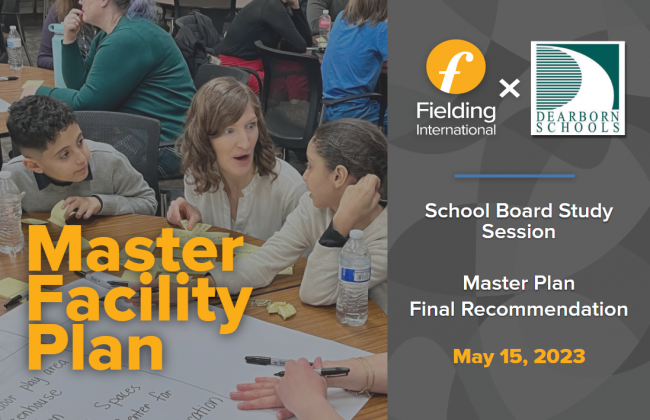With an aging inventory of buildings and an ever growing demand on the amount of time schools are being used during the year, it’s clear the infrastructure needs of our schools require immediate attention. Those same reasons also support the need for a broader discussion on the future of our schools in Dearborn.
Fielding International, a firm hired by the Board of Education in 2022, presented the results of their work in the district over the last several months at the May 15, 2023 Board of Education meeting. (See the original May 15 presentation here and the updated May 15 presentation, which was modified to show costs if Fordson is kept a school).
“Really what you have here is a roadmap, and in 10 or 15 years you are really going to have to reevaluate,” said James Seaman, a partner with Fielding International.
The company discussed three main scenarios that offered three very different long range paths for the district to explore. There were not final plans, rather three different visions for the next 30 years.
At one end of the spectrum was a school-by-school plan that would largely keep schools organized as they are with the exception of turning Smith Middle School into a K-8 campus that includes students currently at Nowlin Elementary. All 14 remaining neighborhood elementary schools would also have at least one preschool class in the building. Overall the school-by-school plan would have fifteen schools replaced, eight receive additions, and seven be renovated for a projected cost of $1.4 billion.
At the other end of the scale, a community campus plan would reorganize almost every school, creating 14 separate kindergarten to eighth grade schools and five preschool buildings across the district. The district’s three traditional high schools – Fordson, Dearborn High and Edsel – would be moved to one large campus, although each high school would operate as a distinct high school on that campus. Students attending Lowrey K-8 School would then move to the current Fordson High building. The estimated cost of this scenario would be $1.7 billion.
Between those two concepts Fielding presented a hybrid scenario. The three high schools would still be combined on one campus, but most elementary and middle schools would remain, at least in name. The plan still calls for replacing 14 school buildings, additions at seven schools and renovating eight more. Five buildings would be closed. The estimated building cost would be $1.7 billion.
All three scenarios would take more than two decades to fully implement. Estimated figures are current estimates for construction and do not include other considerations such as busing costs, energy efficiency or adding air conditioning to existing buildings.
After Fielding International’s presentation, Executive Director of Business Services and Operations Tom Wall sketched out possible financing if the district opted to completely adopt one of the scenarios.
To fund $1.3 billion of work would require district voters to approve about another 6 mills in taxes, Mr. Wall said. For comparison, district residents paid 3.5 mills toward the district’s debt millage last year, but that will fall to about 1.3 mills on this summer’s tax bill. The additional 6 mills would allow the district to complete about $100 million in construction every three to four years.
Fielding International recommended the district spend the next several months gathering stakeholder feedback and honing their broad scenarios into a more specific plan.
Board of Education members plan to again discuss Fielding’s scenarios at their regular July meeting, tentatively set for July 24. After that discussion, the district expects to plan some town halls and other sessions to gather more community input as families and staff return from the summer break.
“Just like a strategic plan, you can’t really plan that far out, but you have to have a vision of where you are going so we have some kind of process to review as we go along,” Mr. Wall told trustees.
A new construction millage is not expected to appear on the ballot for at least a year.

